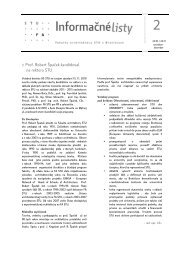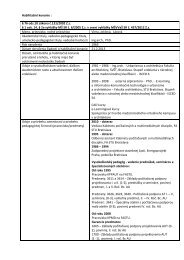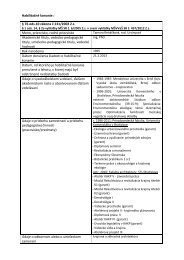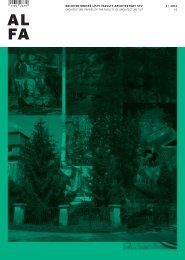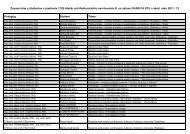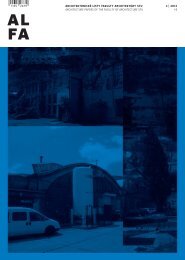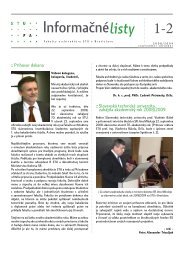ÄasÅ¥ - Fakulta architektúry STU
ÄasÅ¥ - Fakulta architektúry STU
ÄasÅ¥ - Fakulta architektúry STU
- No tags were found...
Create successful ePaper yourself
Turn your PDF publications into a flip-book with our unique Google optimized e-Paper software.
Historic Development and the Analysis of the Square<br />
and its Surroundings<br />
The history of Krupina, one of the major towns in the Banská Bystrica region,<br />
dates back to the Middle Ages. The town influenced by German colonists was<br />
already in 13th century an important medieval Great-Hungarian town and<br />
the centre of the area thanks to its convenient location on the Via Magna<br />
trade route. Initially the town’s development was concentrated around the<br />
Romanesque Church of the Virgin Mary’s Birth. The main Svätotrojičné Square<br />
was formed in a relatively short time, which is reflected in its orthogonal<br />
ground plan. The square was flanked by wealthy burgher houses. Later the<br />
town hall was built and the square, with its weekly markets and regular fairs,<br />
became the centre of public life.<br />
Nowadays the town has nearly 8,000 inhabitants and its location thanks to its<br />
proximity to the important traffic junction in the town of Zvolen is advantageous.<br />
The heritage of the town has been preserved within the protected historic zone,<br />
which copies the outline of the original fortification walls.<br />
The main compositional axis of the town as well as of the Svätotrojičné Square<br />
is orientated north-south. The original function of the square as a place<br />
for markets and fairs has in the course of the 700-year development been<br />
gradually transformed into a predominant traffic function, which noticeably<br />
influences the perception of the square. The main square has a rectangular plan<br />
(approximately 70m x 120m) and is the core part of the historically protected<br />
area of the town.<br />
The most prominent vertical element of the south-eastern part of the square<br />
is the church’s clock tower with a bell-tower. On the main compositional axis is<br />
placed the Holly Trinity Column, while the most significant part of the shorter<br />
axis is the Municipal Office building. On the crossing of the axes is located<br />
an architectural water element - a fountain with a statue of Marína, the main<br />
character of a love poem by Sládkovič. Several of the burgher houses are<br />
original and a protected part of the town’s heritage. The built-up area on the<br />
square does not basically surpass three above-ground levels.<br />
The catalogue presents 17 projects dealing with possible design solutions<br />
10<br />
Bakalárske práce 2010/2011<br />
for Svätotrojičné Square in Krupina, including both architectural and urbanplanning<br />
aspects. The projects were elaborated by students of the Faculty<br />
of Architecture in the academic year 2010/2011 as their Bachelor’s thesis<br />
assignment. The different approach and individual point of view of each author<br />
as regards their solutions resulted in the conceptual diversity of the final<br />
designs. Despite their common starting points, each work carries its specific<br />
and inventive resolution in terms of the arrangement of functions and elements<br />
in the space of the square.<br />
The first step in the assignment was the analysis of the space and the subsequent<br />
identification of potentials and problems of the square. Looking more closely at<br />
the square’s wider surroundings revealed the possibilities for connecting this<br />
space with the major points of the town, such as the bus station, SNP Square,<br />
housing estate, Roman-Catholic church, Greek-Catholic church, park of Andrej<br />
Sládkovič, cinema, hospital, cemetery, department store and amphitheatre. The<br />
vicinity of the river Krupinica was seen as one of the further potential areas<br />
for relaxation and recreation.<br />
Commercial facilities present the predominant function of the square in the<br />
parterre, accompanied by civic amenities such as the municipal office, post office,<br />
market hall, Protestant church and parsonage. Housing is concentrated to the<br />
higher above-ground levels. The heritage of the fruit-growing tradition is seen<br />
in the existence of long underground corridors discovered under many of the<br />
houses in the square. They most probably served as storage spaces.<br />
As already mentioned, Svätotrojičné Square in Krupina is at present<br />
predominantly used by traffic. This issue was seen by the students as a main<br />
problem for this area. A busy main regional road runs through the square and<br />
the western part of the square is blocked by static traffic – thus preventing the<br />
development of suitable public spaces for organizing markets, fairs and other<br />
events.<br />
In their projects the students also dealt with the possibilities of suitable and<br />
proportional distribution of functions in the buildings flanking the square. They<br />
suggested giving more space to cafés and restaurants instead of simply grocery<br />
stores and administrative spaces. From the compositional point of view the identity<br />
of square is disturbed by buildings from the second half of the 20th century<br />
(e.g. post office, Jednota supermarket etc.) due to their inappropriate position<br />
in the historic setting of the square. The Holly Trinity Column, the fountain<br />
with the statue of Marína and the memorial of the Slovak National Uprising<br />
are set on one line running through the centre of the square. According to<br />
some students the fountain and the partisan memorial are disruptive elements in<br />
the present state of the square. The inhomogeneous and non-coherent smaller<br />
architectural pieces and street furniture are also perceived negatively.<br />
The square has rich greenery formed by a rather excessive range of plants.<br />
Despite its well-kept appearance and its partial concentration on the minor<br />
compositional axis, the students found the present greenery compositionally<br />
inappropriate.<br />
Pursuant to these presented analyses the students of the Faculty of<br />
Architecture in Bratislava started work on their renovation projects for<br />
Svätotrojičné Square in Krupina.<br />
Kamila Gejdošová (summary of analyses)



